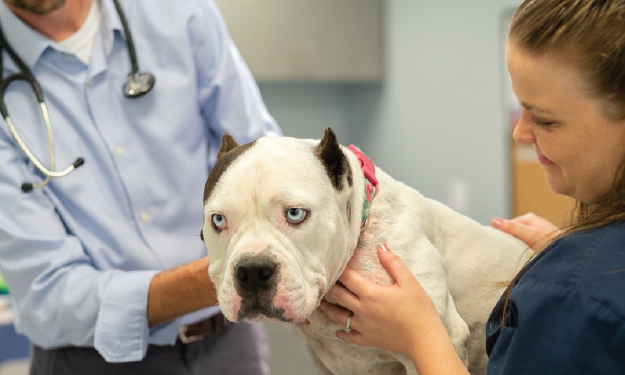Nasal Cancer in Dogs & Cats

What types of Nasal Tumors are there?
Nasal tumors are somewhat common in dogs making up about 1% of all cancers, and less in cats. The most common nasal tumors in dogs are carcinomas, followed by sarcomas. In cats, lymphoma and carcinoma are the most common nasal tumors.
What are the Symptoms?
Symptoms often include progressive nasal discharge, sneezing, and/or nasal bleeding. This often starts on one side, and may progress to involve both nostrils. These signs often temporarily improve with symptomatic treatments, such as antibiotics and/or anti-inflammatory medications. Nasal tumors may progress to cause swelling or deformity of the face/muzzle, the oral cavity, or the eye. In some instances, neurologic signs from extension into the brain can be seen.
How is it Diagnosed?
Diagnosis usually involves thorough examination, including oral examination, diagnostic imaging, and biopsy. A CT is often more sensitive than radiographs. Endoscopy is also commonly utilized to visualize the tissue, and to obtain a diagnostic biopsy. Imaging and biopsy findings help to determine the prognosis and direct treatment.
What are the Treatment Options?
- Surgery: Surgery alone has generally not been shown to improve survival significantly in animals with nasal tumors. In part, this is likely due to the advanced stage of disease that many animals present with. It also requires opening of the nasal cavity, and results have significant side effects. In some cases, combining surgery with other treatments may be beneficial.
- Radiation Therapy: Radiation therapy is the primary treatment of choice for nasal tumors. Radiation has the advantage of treating the entire nasal cavity, as well as any bones or sinuses that may be involved. Radiation results in resolution or improvement of clinical signs in the majority of patients. Long-term outcomes and side effects from treatment vary depending upon the stage and type of tumor.
- Chemotherapy: Chemotherapy may be useful in the treatment of nasal tumors. When used alone, responses are
typically short-lived. In some cases, combining chemotherapy with radiation therapy (either concurrently or sequentially) may improve responses. - Medical management: Medical management of nasal tumors depends on what the clinical signs are, but often involves antibiotics to treat secondary infections, and/or anti-inflammatory drugs.
What is the Prognosis?
There are many factors that may influence the prognosis of animals with nasal tumors. The specific tumor type is important; the stage or extent of disease as assessed by examination and imaging is also important. Without treatment, the average prognosis is 2-3 months. The average prognosis with radiation treatment for most animals is 9-15 months, although it may be better or worse depending on the tumor type and stage.
What Course(s) of Radiation are Recommended?
Definitive radiation therapy is our recommended protocol for most patients; it involves daily treatments for 3-4 weeks given on a once daily schedule Monday through Friday. Many other protocols and treatment techniques have been attempted in an effort to either improve long-term outcomes, and/or reduce side effects, depending on specific treatment circumstances and goals. Specifically, there are techniques that involve giving higher radiation doses over a shorter time in an effort to improve long-term outcomes. There are also palliative radiation courses that have fewer treatments and side effects, which are sometimes recommended for animals with nasal tumors that may have a more guarded prognosis. Your radiation oncologist can discuss these potential alternative approaches with you.
What Side Effects May Be Seen with Radiation Therapy of Nasal Tumors?
Pets develop radiation dermatitis and mucositis around week 3-4 after starting treatment. Side effects are limited to the treatment field, which depends on the extent of the tumor. In most pets, there is usually at least one eye that is included in the radiation field. There can be redness and discharge, particularly around the eyes. Animals often need to wear an Elizabethan collar to prevent scratching/rubbing at the area. Your pet may be prescribed antibiotics and/or anti-inflammatory medications to manage these reactions; analgesics can also be prescribed if needed. Your pet should be encouraged to eat soft, moist foods during the treatment and recovery period. Acute radiation effects usually get progressively worse, until about 2 weeks after completion of therapy, and then heal over the next 2-4 weeks.
As acute reactions heal, the skin may lose hair or pigmentation. There can be changes to the eye(s) in the radiation field. It is also common for animals to have some mild persistent nasal discharge, due to changes to the nasal cavity from the tumor. With any radiation protocol there is a low (<5%) risk of serious late effects, which can be complications due to treatment, typically seen 1-5+ years after treatment. Your radiation oncologist will discuss any specific concerns regarding radiation side effects based on your pet’s treatment field.